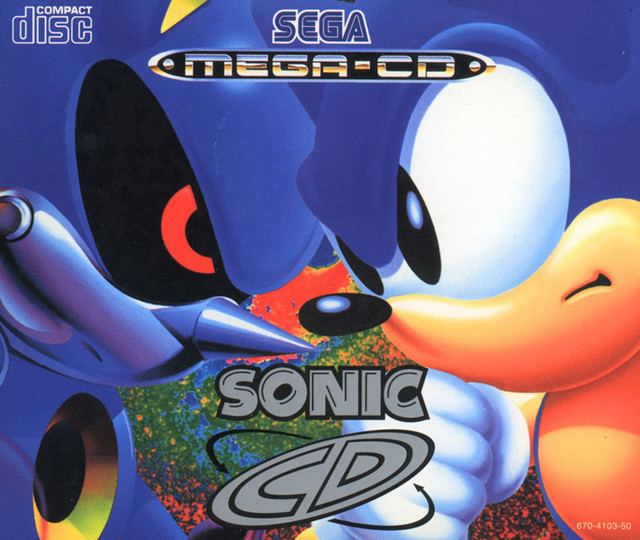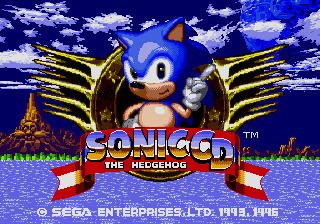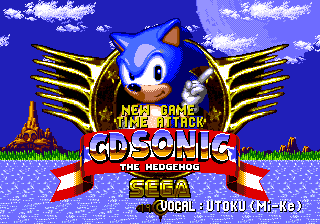8 /10 1 Votes
Publisher(s) Sega Director(s) Naoto Ohshima Series Sonic the Hedgehog Developers Sega, Sonic Team | 8/10 Play Mob Org Distributor(s) SoftKey (PC retail) Initial release date 23 September 1993 Genre Platform game | |||||||||||||||||||||||||||||||||
 | ||||||||||||||||||||||||||||||||||
Producer(s) Minoru Kanari
Makoto Oshitani Artist(s) Kazuyuki Hoshino
Takumi Miyake Composer(s) Japanese/European version:
Naofumi Hataya
Masafumi Ogata
North American version:
Spencer Nilsen
David Young
Mark Crew Platforms Android, iOS, PlayStation 3, Xbox 360, Microsoft Windows, Windows Phone, Sega CD, Ouya Designers Naoto Ohshima, Kazuyuki Hoshino, Yasushi Yamaguchi Similar Sonic the Hedgehog games, Sega games, Platform games | ||||||||||||||||||||||||||||||||||
Cgrundertow sonic the hedgehog cd for xbox 360 video game review
Sonic the Hedgehog CD, more commonly known as Sonic CD, is a platform video game developed by Sonic Team and published by Sega originally for the Sega CD in 1993. It is the third main installment in the Sonic the Hedgehog series (following Sonic the Hedgehog 2), and the first game in the series to make use of the CD-ROM format, featuring high-quality audio and full motion video. Development began in Japan in 1991, and was originally developed alongside Sonic the Hedgehog 2 as the same project, but was split into different games shortly after production began.
Contents
- Cgrundertow sonic the hedgehog cd for xbox 360 video game review
- Ror sonic the hedgehog cd sega cd vs ios android
- Gameplay
- Plot
- Development
- Music
- Microsoft Windows
- Sonic Gems Collection
- Nintendo DS
- 2011 re release
- Reception
- Legacy
- References

The story of Sonic CD follows Sonic the Hedgehog as he uses time travel to save Amy Rose and Little Planet from Doctor Robotnik and Metal Sonic. The game features the debut appearances of Amy Rose and Metal Sonic, both of whom have gone on to become recurring characters in the Sonic series. Time travel is a key aspect to both the story and gameplay, with nearly every stage containing four different variations (one for each time period) featuring alternate stage layouts, music, and graphics.

Sonic CD received critical acclaim, being considered both one of the best platform and Sega CD games of all-time. It was ported to Microsoft Windows as part of the Sega PC brand in 1996, and to both the PlayStation 2 and GameCube as part of Sonic Gems Collection in 2005. An enhanced port of the game was also released for Xbox Live Arcade, PlayStation Network, iOS, Android, Microsoft Windows, Windows Phone, Ouya, and Apple TV.
Ror sonic the hedgehog cd sega cd vs ios android
Gameplay
Sonic the Hedgehog CD is a platform game in which the player character is the titular Sonic the Hedgehog. The goal of the game is to collect seven Time Stones and defeat Sonic's nemesis Doctor Robotnik. Along the way, Sonic can collect rings, which can protect him if he is hit by an enemy or obstacle, as well as items such as shields, invincibility, and speed shoes. Sonic's gameplay remains similar to that of Sonic the Hedgehog but with the addition of the Spin Dash and the Super Peel Out, which lets him zoom into a quick speed from a standing point, respectively in a rolling or running position. The Super Peel Out is faster than the Spin Dash but leaves Sonic more vulnerable. Each of the game's seven themed rounds is divided into three "zones": two main levels and a boss level.
The main gameplay mechanic that sets Sonic CD apart from other Sonic games is a time travel system that enables players to move between different time periods within each level. By hitting posts labeled "past" or "future" and then keeping a consistently high speed for several seconds, Sonic can move between past, present and future level variants. The time travel posts are only present in the first two zones of each stage; boss zones always take place in the future.
The game contains four different variants of each zone ("past", "present", "good future" and "bad future"), each of which features different graphics, music, and layouts of platforms, enemies, and obstacles. By default, traveling to the future will take Sonic to a "bad future" version of the current level, an industrialized dystopia with scenery themed around neglect and decay, in which enemy robots exhibit signs of degradation. Therefore, players are encouraged to convert each zone's timeline to a "good future": a utopic technogaian scenario in which technology and nature are symbiotically fused into a sustainable, colorful environment, and in which there are no enemy robots. In each non-boss zone, a good future can be attained by traveling to the past: a plant-overgrown version of the stage with few enemy robots and muted, natural colors. Players must destroy a hidden "robot transporter" in order to obtain a good future. If a good future is achieved in both of a stage's non-boss zones, that level's boss fight will also take place in the good future.
Similar to Sonic the Hedgehog, if a player has more than 50 rings by the end of the act, a giant ring appears that can take Sonic to a Special Stage if he jumps into it. On a three-dimensional plane, the player has a short amount of time to destroy several purple UFOs floating around the level. Time is quickly reduced if the player runs through water, though a blue UFO which appears when time is running out can grant extra time if destroyed. If the player is able to destroy all the purple UFOs before the time runs out, a Time Stone is earned. A good ending can be achieved by collecting all seven Time Stones, or by achieving a "good future" in every act. The player will also automatically achieve a "good future" in any level if all the Time Stones have been collected.
Sonic CD contains a "backup save", using the internal Mega-CD memory or a backup RAM cartridge. The game saves after the end of each level (after which, a new level begins) and records the best times of the player in the Time Attack mode. In the 2011 version, the game is saved at the end of each zone. The game also features an instant game over scenario: if the game is not paused and is left alone for three minutes, Sonic will leap off the screen.
In the 2011 version, players are also able to control Miles "Tails" Prower after clearing the game once. He has his moveset from Sonic the Hedgehog 3: as with Sonic, Tails can use the Spin Attack and Spin Dash, and has the added ability to fly and swim, but is unable to use the Super Peel Out and cannot be used to earn achievements. Players also have the option to utilize the Spin Dash physics from Sonic the Hedgehog 2, allowing the player to charge and more quickly use the Spin Dash.
Plot
Sonic arrives at Never Lake where the fabled Little Planet (also known as "Miracle Planet") is said to appear on the last month of every year. There, he finds the planet tethered to a mountain by a chain and completely mechanized. Sonic realizes this is the work of series antagonist Doctor Robotnik, who has built a base on the planet to transform it into a giant fortress. Upon discovering Sonic's presence, he dispatches Metal Sonic to kidnap a young female hedgehog called Amy Rose, who had followed Sonic to the area. Sonic is tasked with collecting the Time Stones - seven jewels capable of altering the passage of time - and saving Amy Rose.
After chasing Robotnik from his weapons factory, in the Stardust Speedway Sonic encounters Metal Sonic again, who clash as they both try to escape while Robotnik destroys Stardust Speedway. Metal Sonic fails to escape and is severely damaged, and Sonic battles Robotnik afterward in his base. Following the Doctor's defeat, Sonic and Amy escape as Little Planet breaks free of its tether. Two endings exist, dependent on whether or not the player had Sonic collect all of the Time Stones. In the game's "good" ending, Little Planet is returned to its rightful state and leaves Never Lake, illuminating itself in the shape of Sonic's head to thank him. In the game's "bad" ending, Little Planet leaves Never Lake but is left under Robotnik's rule, in a decaying, mechanized state, and Sonic watches him escape with the Time Stones in hand. In a post-credits scene, time resets, causing Little Planet to reappear at the lake, and Sonic returns to save it once and for all.
Development
Following the release of Sonic the Hedgehog, lead programmer Yuji Naka had grown dissatisfied with the rigid corporate policies at Sega and moved to the United States to work with the Sega Technical Institute, along with several members of Sonic Team, to develop Sonic the Hedgehog 2. Meanwhile, in Japan, a separate development team headed by Sonic creator Naoto Ohshima handled development on Sonic CD. This game and Sonic 2 were initially intended to be one and the same, but during development, Sonic CD evolved into a vastly different type of game. The game is the first in the series to feature animated cutscenes, which were produced by Toei Animation, with co-operation from Studio Junio.
The 2011 port was developed from scratch by using the Retro Engine created by independent developer Christian "Taxman" Whitehead, who originally produced a proof-of-concept video of the game running on the iPhone in 2009. Whitehead also designed two additional stages, "Desert Dazzle" and "Final Fever", however, they were not included in the final release.
Music
There are two different soundtracks for the game, one which was used for the Japanese, European, and Australian releases of the game, and another used for the North American version. The original Japanese soundtrack was composed by Naofumi Hataya and Masafumi Ogata, who had previously worked together on the 8-bit version of Sonic the Hedgehog 2. The theme songs were entitled "Sonic - You Can Do Anything", composed by Ogata and originally written for Sonic the Hedgehog 2, and "Cosmic Eternity - Believe in Yourself", composed by Hataya. The boss music for the Japanese version was also noted for sampling the song "Work That Sucker To Death" by American artists Xavier, Bootsy Collins, and George Clinton. The North American version was delayed a few months to have a new soundtrack written and produced by Spencer Nilsen, David Young, and Mark Crew. All the music, save for the "Past" tunes which were in sequenced PCM audio rather than Mixed Mode CD-DA, were replaced, and the theme tunes were replaced with "Sonic Boom", composed by Nilsen and performed by Pastiche, which consisted of Sandy Cressman, Jenny Meltzer, and Becky West.
The 2011 re-release of Sonic CD features the original soundtrack. Although the inclusion of the North American soundtrack was initially uncertain due to licensing issues, it was later revealed that the North American soundtrack was to be included, with the option to switch between the two soundtracks. However, both "Sonic - You Can Do Anything" and "Cosmic Eternity - Believe in Yourself" were replaced by instrumental versions, as the rights to the lyrics belonged to Casey Rankin, who died in 2009. A 20th Anniversary soundtrack CD was released in Japan on November 23, 2011, featuring remastered versions of the original soundtrack, along with the inclusion of "Sonic Boom", and exclusive arrangements by Cash Cash and Crush 40.
Microsoft Windows
Sonic CD was ported to PC CD-ROM in 1996 as part of the Sega PC brand, making it the first Sonic game released on personal computers. This version was released in Japan on August 9, 1996, in North America on August 26, 1996, and in Europe on October 3, 1996. The PC version is largely identical to the original Mega-CD release, however, it contains the complete FMV animated intro and ending sequence, and all versions of the game, including the Japanese version, uses the North American soundtrack. Prior to the game's 2011 re-release, the game was only compatible with Windows 9x-based computers without being patched unofficially.
Sonic Gems Collection
Sonic CD was planned to be included in Sonic Mega Collection for the Nintendo GameCube, Xbox, and PlayStation 2, but was left out in the final release. However, the game was released as part of the Sonic Gems Collection compilation released for Nintendo GameCube and PlayStation 2 in 2005. This version is an emulated port of the PC version with an improved frame rate, although minor bugs are present and certain features (such as debug mode) cannot be used properly. This version of the game was positively received, with Juan Castro of IGN claiming the title "stands out" compared to the other games included in Sonic Gems Collection.
Nintendo DS
Prior to the release of the 2011 version of Sonic CD, Simon "Stealth" Thomley, who assisted in its early development, created an unofficial demo version of Sonic CD for the Nintendo DS. This version features completed Palmtree Panic and special stages, and the option to play as Tails or Knuckles the Echidna. The unfinished proof-of-concept was a specialized, native port written specifically for using the DS hardware, which did not have the raw processing power to handle the generalized Retro Engine's script interpretation and software rendering. It was, however, cancelled due to the DS nearing the end of its life cycle, diminishing the usefulness a light-weight alternative in light of Sega's existing commitment to the Retro Engine version.
2011 re-release
On August 25, 2011, Sonic CD was released on Xbox Live Arcade and the European PlayStation Network on December 14, 2011, followed by the iOS App Store and Android Market on December 15, 2011 and the North American PlayStation Network on December 20, 2011. The PC version was released on January 19, 2012. A Windows Phone version was released in November 2012. Prior to the game's release, Android gaming tablets purchased from GameStop from November 2011 contained the full game. This version allows support for widescreen graphics and spin dash physics from Sonic 2. Players are also able to unlock Tails as a playable character. The port features both the original Japanese/European soundtrack and the American soundtrack, as well as achievement and trophy support and iOS features. It game was released on the Ouya console on August 1, 2013. Sonic CD was also released on Apple TV on March 31, 2016. The iOS version was released for free on October 30, 2016. However, the version features in-app advertisements, and users must pay the game's normal price to disable them.
Reception
The original Mega-CD version of Sonic CD received acclaim, with a consensus that it was one of the best games for the platform. The game was praised for its innovative time-travel based gameplay, presentation, and music. It became the platform's best-seller. The Android version later sold more than 100,000 paid downloads.
Mega placed Sonic CD at #3 on their list of the Top 10 Mega-CD Games of All Time. The game was awarded Best Sega CD Game of 1993 by Electronic Gaming Monthly. In May 2009, GamePro listed Sonic CD as one of the Top 20 Best Platformers: 1989 to 2009, ranking the game in 12th place. GamesRadar listed Sonic CD as the 68th best game of all time.
The 2011 re-release also received positive reviews, with the iOS version in particular garnering high acclaim from reviewers. The iOS version garnered a score of 93 out of 100 on Metacritic, becoming the highest rated Sonic game on the website as well as being the website's second-highest rated iOS game of 2011 (losing only to World of Goo); while the XBLA and PSN versions of the game received a score of 82 out of 100 and an 80 out of 100, respectively. IGN praised the 2011 rerelease, scoring 8.5 for the XBLA version and 9.0 for the iOS version. GamesRadar gave the game 9/10, mentioning that the iPhone version conversion, in particular, is "incredible". Sonic CD hit the number one spot on PSN Top Sellers for December 2011. In March 2013, the game was nominated for and won the Windows Phone Game of the Year category of the Pocket Gamer Awards.
Legacy
The story of Sonic CD was adapted in issues 26 to 28 of Egmont Fleetway's Sonic the Comic magazine in the UK, where Metal Sonic was renamed Metallix. The game's story was also adapted in issue #25 of Archie Comics' Sonic the Hedgehog comic book series.
Two characters introduced in the game, Amy Rose and Metal Sonic, are featured in many later games in the Sonic series. Metal Sonic later appears as the main antagonist in 2003's Sonic Heroes. He also appeared as a major antagonist in Sonic the Hedgehog 4: Episode II, whose story heavily connects to Sonic CD's, explaining how he came back following his defeat in CD. Metal Sonic has also appeared in many spin-offs of the Sonic series in cameos or as a playable character. Amy Rose has also gone on to become a character in many subsequent games as well, most notably in Sonic Adventure.
For the series' 20th anniversary, Sega released Sonic Generations, a game that remade aspects of various past games from the franchise. It features a remake of the Sonic CD boss battle against Metal Sonic, set in the bad future of Stardust Speedway. In the Nintendo 3DS version, the battle takes place in a Sonic the Hedgehog 2 themed "Casino Night" level which contains a level design highly reminiscent of the original level.
